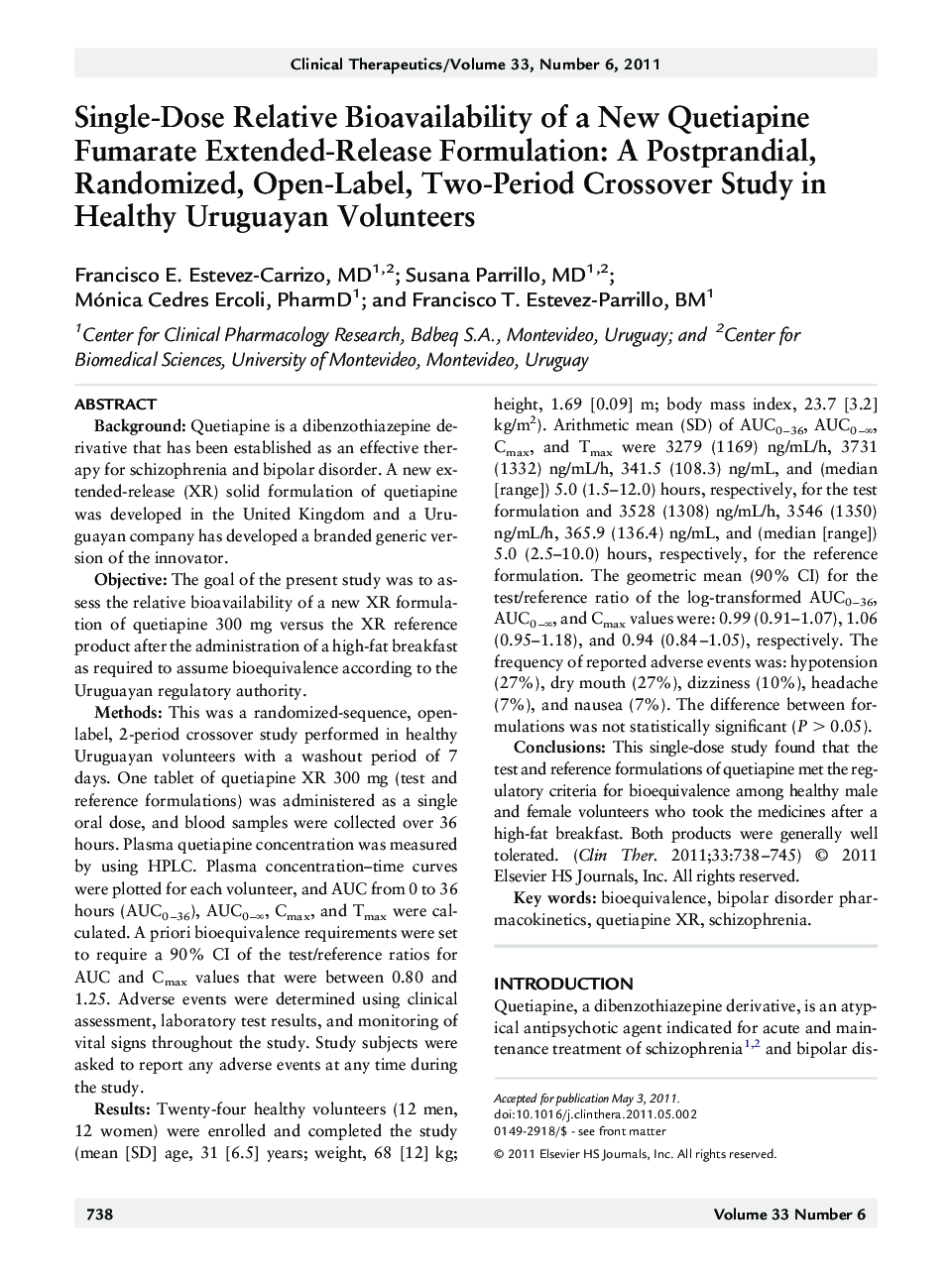| کد مقاله | کد نشریه | سال انتشار | مقاله انگلیسی | نسخه تمام متن |
|---|---|---|---|---|
| 2527551 | 1119925 | 2011 | 8 صفحه PDF | دانلود رایگان |

BackgroundQuetiapine is a dibenzothiazepine derivative that has been established as an effective therapy for schizophrenia and bipolar disorder. A new extended-release (XR) solid formulation of quetiapine was developed in the United Kingdom and a Uruguayan company has developed a branded generic version of the innovator.ObjectiveThe goal of the present study was to assess the relative bioavailability of a new XR formulation of quetiapine 300 mg versus the XR reference product after the administration of a high-fat breakfast as required to assume bioequivalence according to the Uruguayan regulatory authority.MethodsThis was a randomized-sequence, open-label, 2-period crossover study performed in healthy Uruguayan volunteers with a washout period of 7 days. One tablet of quetiapine XR 300 mg (test and reference formulations) was administered as a single oral dose, and blood samples were collected over 36 hours. Plasma quetiapine concentration was measured by using HPLC. Plasma concentration–time curves were plotted for each volunteer, and AUC from 0 to 36 hours (AUC0–36), AUC0–∞, Cmax, and Tmax were calculated. A priori bioequivalence requirements were set to require a 90% CI of the test/reference ratios for AUC and Cmax values that were between 0.80 and 1.25. Adverse events were determined using clinical assessment, laboratory test results, and monitoring of vital signs throughout the study. Study subjects were asked to report any adverse events at any time during the study.ResultsTwenty-four healthy volunteers (12 men, 12 women) were enrolled and completed the study (mean [SD] age, 31 [6.5] years; weight, 68 [12] kg; height, 1.69 [0.09] m; body mass index, 23.7 [3.2] kg/m2). Arithmetic mean (SD) of AUC0–36, AUC0–∞, Cmax, and Tmax were 3279 (1169) ng/mL/h, 3731 (1332) ng/mL/h, 341.5 (108.3) ng/mL, and (median [range]) 5.0 (1.5–12.0) hours, respectively, for the test formulation and 3528 (1308) ng/mL/h, 3546 (1350) ng/mL/h, 365.9 (136.4) ng/mL, and (median [range]) 5.0 (2.5–10.0) hours, respectively, for the reference formulation. The geometric mean (90% CI) for the test/reference ratio of the log-transformed AUC0–36, AUC0–∞, and Cmax values were: 0.99 (0.91–1.07), 1.06 (0.95–1.18), and 0.94 (0.84–1.05), respectively. The frequency of reported adverse events was: hypotension (27%), dry mouth (27%), dizziness (10%), headache (7%), and nausea (7%). The difference between formulations was not statistically significant (P > 0.05).ConclusionsThis single-dose study found that the test and reference formulations of quetiapine met the regulatory criteria for bioequivalence among healthy male and female volunteers who took the medicines after a high-fat breakfast. Both products were generally well tolerated.
Journal: Clinical Therapeutics - Volume 33, Issue 6, June 2011, Pages 738–745